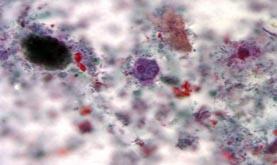 Amebiasis is an infection of the gastrointestinal system. It is not common in Canada, and occurs more often in parts of the world where there is poor sanitation, such as in Mexico, Central America, western South America, southern Asia and western and southern Africa. Travellers to these areas are at risk of becoming infected, if they do not take precautions with food and drinking water.
Amebiasis is an infection of the gastrointestinal system. It is not common in Canada, and occurs more often in parts of the world where there is poor sanitation, such as in Mexico, Central America, western South America, southern Asia and western and southern Africa. Travellers to these areas are at risk of becoming infected, if they do not take precautions with food and drinking water.
Information for Health Professionals
Amebiasis is an infection of the intestinal tract caused by a one-celled parasite called Entamoeba histolytica. Although most cases have no symptoms (asymptomatic), the disease can also range from mild to serious (referred to as amebic dysentery). Although anyone can have this disease, it is more common in people who live in tropical areas with poor sanitary conditions. In Canada, amebiasis is most often found in travellers to, and immigrants from these areas. Men who have sex with men can also become infected.
Only about 10% to 20% of people who are infected with E. histolytica become sick from the infection. The symptoms often are quite mild and can include loose stools, stomach pain, and stomach cramping.
Amebic dysentery is a severe form of amebiasis associated with stomach pain, bloody stools, and fever. Rarely, E.
histolyticainvades the liver and forms an abscess. Even less commonly, it spreads to other parts of the body, such as the lungs or brain.
- Some people experience mild abdominal discomfort, with diarrhea, possibly containing blood or mucus, and sometimes alternating with constipation.
- Severe cases have fever, chills and bloody or mucoid diarrhea.
- In some instances, the disease-causing organism (pathogen) can invade other parts of the body.
- Amebiasis is caused by a single-celled parasitic organism called Entamoeba histolytica / dispar. It is found only in human beings.
- Infection is caused by ingesting food or water contaminated by the feces of someone who is ill.
- Transmission can occur, too, through anal-oral sexual practices.
Only about 10% to 20% of people who are infected become sick. Those people who do become sick usually develop symptoms within 2 to 4 weeks, although this may range to several weeks or longer.
- The pathogen can invade the body's tissues (via the blood), and result in liver, lung or even brain abscesses.
- Ulceration of the skin can also occur in the perianal region.
- Diagnosis is made by microscopic examination of stool samples or portions of infected tissue.
- Also, biochemical testing can determine the presence of the pathogen.
- Asymptomatic individuals can be treated with a luminal amebicide to prevent symptoms.
- Those with symptoms can be treated with a systemically-active compound, followed by a luminal amebicide.
The most important part of any communicable disease is prevention. The following steps will minimize the chances of becoming ill:p
- Protect food and water from fecal contamination.
- Do not allow someone ill with amebiasis to prepare food.
- Disinfect water from sources that could be contaminated, by using an appropriate iodine solution or by boiling for a period of 1 minute; 2 minutes if you are at an altitude of 2000 metres or more. See HealthLink BC File #49b: How to Disinfect Drinking Water
- Always wash your hands with soap and warm water for 30 seconds before preparing food.
Reference:
Control of Communicable Diseases Manual, Heymann, 2008

